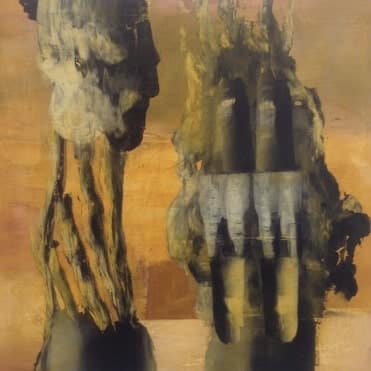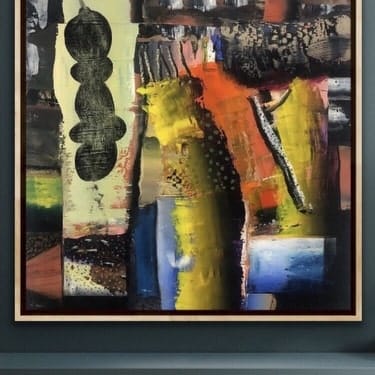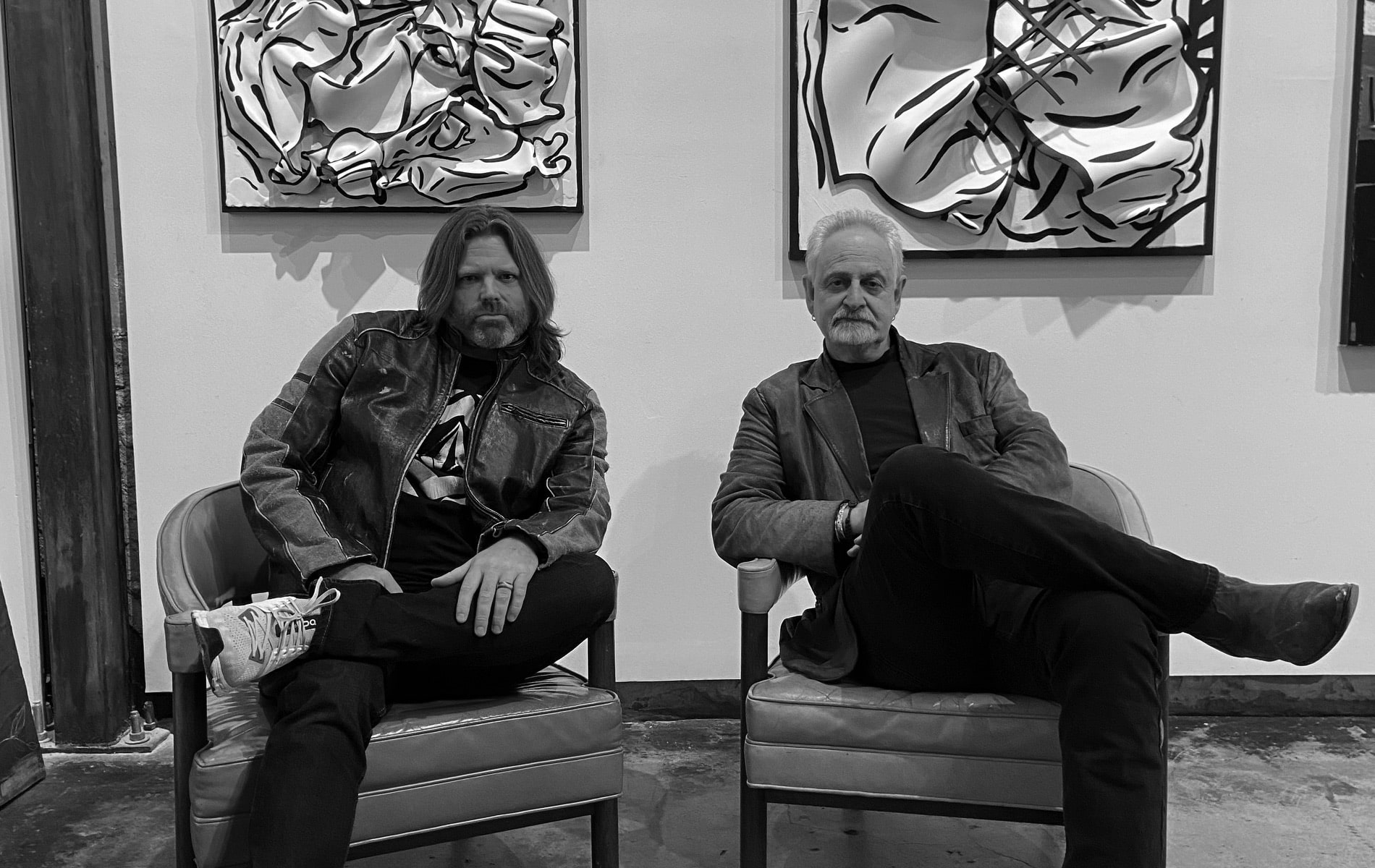
VIE_Magazine_MAR23_article_Jay_Etkin_HERO-min
Artist Nathan Alan Yoakum and his mentor, artist and gallerist Jay Etkin, in front of some of Yoakum’s sculptural resin works at Jay Etkin Gallery in Memphis
Mentoring Is an Art Form
By Jordan Staggs | Photography courtesy of Jay Etkin Gallery
Sometimes those who impact others most are not direct family members, influential celebrities, politicians, or philanthropists—they are mentors. Finding a person who believes in what you are doing enough to give candid advice and support can be life-changing. For some, especially in creative fields, it can make the difference between giving up or pushing through to complete a project or goal. Jay Etkin might not be a household name, but he has made a difference in the lives of countless artists. He says relationships and connections have driven his life and career as a successful artist, gallery owner, instructor, and museum director.
“I do not encourage young artists to get into the market or focus on selling,” Etkin notes, which may seem counterintuitive to those who want to make a living from their art. Still, his advice is sound. “Those early years should be devoted to building one’s technical skills and, equally important, building one’s ideas.”
Etkin was born in the Bronx, New York, and began creating art “as far back as I can remember”—mostly painting. He graduated from Brooklyn College with a degree in fine arts and education and apprenticed under realist painter Philip Pearlstein, also serving as his studio assistant. Learning from Pearlstein and others in the industry and growing up in the city deepened Etkin’s appreciation for creators.
“I had art around me, and living in New York allowed me, as I got a bit older, opportunities to visit galleries and museums,” he recalls. “I had mentors who were artists, but I also had mentors who were well-known New York art dealers.”
Inspired by his mentors and wanting to see fellow artists succeed, he developed a desire to help others. In the early 1970s, he began running outreach programs for at-risk children, teaching them that the arts can be a healthy way to express emotions and spend time over activities that may get them into trouble. He also worked as an instructor and illustrator and has been passionate about running galleries and alternative art spaces for decades. Etkin collaborates with the dance and theater communities, as well as writers, musicians, and filmmakers, supporting the arts however he can.

Artwork by Johnny Taylor
Etkin arrived in Memphis in 1983 for an exhibition at the old Art Academy (Memphis College of Art) and says he was well-received and quickly made many friends in the community. He rented a midtown studio that year, intending to stay in Memphis for three months to paint and get acquainted with the South. “I was indeed inspired and, shortly thereafter, moved here full-time.” He’s been a proud Memphian ever since, passionately supporting the arts and artists in the city while growing his business.
“In my early years, I focused on being in the studio, but I always reflected on my visits to galleries,” he says. “I had a lot of opinions on the value of galleries; I had both positive and negative experiences visiting these artful establishments. Occasionally I felt a bit intimidated, but then I had the simple thought that those dealers would not exist without us artists! That’s when things changed.” Etkin decided to open his own gallery to create meaningful connections and spread the word about up-and-coming artists.
“I witnessed many artists looking for representation but constantly hitting a wall in New York and here in Memphis,” he explains. “I felt I could contribute to building opportunities for artists, so I moved forward with my gallery and have never regretted that decision.”
Today, the Jay Etkin Gallery on South Cooper Street in Memphis represents twenty artists, plus Etkin’s own work.
He says when starting his gallery in 1989, “I focused on career-minded artists wanting to grow, experiment, and impact the viewer. Some were not particularly ‘commercially viable’; their work was challenging but very well crafted. That did not stop me from representing them. At that time, I had already garnered dedicated collectors prior to opening the gallery and even had private viewings in my home. I wanted to further develop that audience. I simply said that I appreciated their support and asked if they would be open to viewing the works of other artists they might not be familiar with. My first gallery sales were from folks who had bought my works prior; that turned into a good business plan. Our audience through the gallery environment grew exponentially, and I live in gratitude!”
One of the artists whose work Etkin shared with his clients is Nathan Alan Yoakum, a mixed-media artist from Memphis who Etkin met in the early 1990s. Yoakum was a promising teenage artist who needed a clear vision for his future and guidance to follow his dreams.
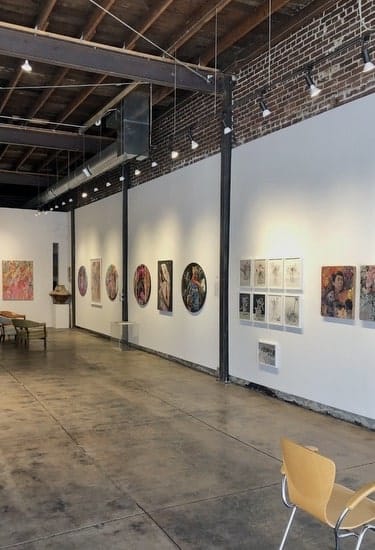
Works on display at Jay Etkin Gallery in Memphis
“Nathan was a teenager when we started chatting about his artwork,” Etkin recalls. “I saw great possibilities for him. I tried not to focus on selling (I believe he was selling some of his work back then) but instead really to understand what to paint and the why behind the work. I watched him develop, and one fine day, I asked him to bring work to hang in the gallery. I constantly challenged him to experiment, grow, study art history, and commit to finding his unique voice as an artist.”
Yoakum, now a successful artist represented in multiple galleries and selling his creative resin sculptures, pop art, mixed-media paintings, and screen prints, has also been a past VIE magazine cover artist and a two-time guest on the VIE Speaks podcast. He credits Etkin as a massive influence in his life, calling Etkin his “art dad” and thanking him profusely for being there when others were not so supportive of his career. He regularly visits the Jay Etkin Gallery in Memphis and has work on display there and in several of Etkin’s residential and commercial projects.
“His newest work of black-and-white dimensional resin and paint is some of his finest—conceptually strong and aesthetically powerful,” Etkin shares of his friend and protégé. “Bravo, Nathan!”
I felt I could contribute to building opportunities for artists, so I moved forward with my gallery and have never regretted that decision.
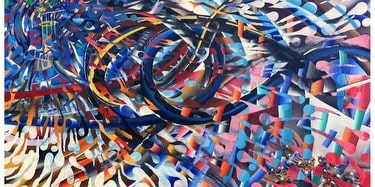
Artwork by Roy Tamboli
The Jay Etkin Gallery has a continually rotating collection of art. Other staple creators who have captured Etkin’s attention and praise include Roy Tamboli, Pam Cobb, Julie Schumer, Johnny Taylor, and Juan Rojo, to name a few. “Each of these is a dedicated, lifelong artist,” Etkin describes. “Each strives for growth, greater skills, and developing new ideas, and they’re stylistically all very different.”
Etkin’s own style varies, but he loves creating abstract concepts and working with oils. “I’ve been painting with oils for over forty-five years, and it’s never boring. I feel as if I’ve just touched the surface of what I can do with paint. I acknowledge the intellectual aspect of painting, but just standing in front of a piece, living, moving, breathing—just doing it will get me to the outcome. Every piece is an adventure.” He continues, “Beauty in abstraction is powerful, with form, color, and technique working together into something very personal. It works on an intimate level that’s intuitive rather than intellectual. I liken myself to a mad scientist in a laboratory whose goal is to make some fantastic thing happen. And as in science, unexpected things do happen. I strive for this experience. The work is sifting through the personal—all those things that affect me.”
This can be quite the challenge, says the mad scientist. “I struggle through each painting, physically and emotionally. It is the passion and commitment to the paint that holds the work together. All the time I spend in the studio, moving, scraping, adding, subtracting, and blending—endless blending—is because I want something to come out of that process.”
Owning and operating a successful gallery for thirty-three years has also been challenging. Still, Etkin wouldn’t change the experience for the world and staunchly believes art galleries have an important place in an increasingly digital market. “I believe in brick-and-mortar, and all my spaces—studios, galleries, and my home—have been gathering places for friends, neighbors, tourists, families, poets, and creatives to gather and chat, share ideas, build friendships, and collaborate. In our digital age, human connection is more critical than ever. I’m a people person and a storyteller. Those kinds of interactions are best served in person, through letter writing, or even emails; texting will never substitute for talking.”
Etkin’s other noble efforts to build relationships have included a museum and cultural center in Memphis, the Flow Museum of Art & Culture. Its focus is traditional African tribal art, Latin American folk art, historical photography, Southern folk art, and vernacular art. Flow’s collection even includes works from the historic photographic archives of the Hooks Brothers Studio that started on Beale Street in 1907 and documented African American life in Memphis for over seventy years.
The gallerist is also working with a team to restore Saint Paul’s Spiritual Holy Temple, an African American religious folk art site in Memphis, now considered a “national treasure,” he says. This was a Masonic Temple, and the family who founded it created art as part of their religious practice.
Etkin’s galleries, the museum, and other spaces he collaborates with also host arts-focused events throughout the year, including opera performances, workshops, flamenco and modern dance performances, programs for children, exhibitions, public art opportunities, mural commissions, private commissions, and more.
In a world where challenges never cease and focusing on good things instead of bad can be difficult, Etkin says he pushes to keep going through “sheer tenacity, a willingness to reinvent oneself as needed, relentlessness, patience, surviving, tolerating the uncertainties, and having faith. Regardless of pandemics, recessions, wars, endless tragedies, and crises in the world around us, we understand the value of art as something that can heal lives and uplift and strengthen communities. You live knowing your gallery’s mission is part of your life’s mission, and you know it will prosper, even when others give up. I believe I impact people’s lives in many positive ways. I’ve told artists in particular not to obsess about selling; building relationships is the needed focus at this time.”
— V —
Visit JayEtkinGallery.com or stop by the gallery at 942 South Cooper Street in Memphis to see incredible art and learn more about this change maker. You can also hear more from artist Nathan Alan Yoakum on VIE Speaks podcast Season Two, so stay tuned for his episode on all your favorite podcast platforms!
Share This Story!
KEEP UP WITH THE LATEST STORIES FROM VIE





